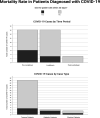The UK Foot and Ankle COVID-19 National (FAlCoN) audit
- PMID: 33829856
- PMCID: PMC8085618
- DOI: 10.1302/2633-1462.24.BJO-2021-0008.R1
The UK Foot and Ankle COVID-19 National (FAlCoN) audit
Abstract
Aims: The primary objective was to determine the incidence of COVID-19 infection and 30-day mortality in patients undergoing foot and ankle surgery during the global pandemic. Secondary objectives were to determine if there was a change in infection and complication profile with changes introduced in practice.
Methods: This UK-based multicentre retrospective national audit studied foot and ankle patients who underwent surgery between 13 January and 31 July 2020, examining time periods pre-UK national lockdown, during lockdown (23 March to 11 May 2020), and post-lockdown. All adult patients undergoing foot and ankle surgery in an operating theatre during the study period were included. A total of 43 centres in England, Scotland, Wales, and Northern Ireland participated. Variables recorded included demographic data, surgical data, comorbidity data, COVID-19 and mortality rates, complications, and infection rates.
Results: A total of 6,644 patients were included. Of the operated patients, 0.52% (n = 35) contracted COVID-19. The overall all-cause 30-day mortality rate was 0.41%, however in patients who contracted COVID-19, the mortality rate was 25.71% (n = 9); this was significantly higher for patients undergoing diabetic foot surgery (75%, n = 3 deaths). Matching for age, American Society of Anesthesiologists (ASA) grade, and comorbidities, the odds ratio of mortality with COVID-19 infection was 11.71 (95% confidence interval 1.55 to 88.74; p = 0.017). There were no differences in surgical complications or infection rates prior to or after lockdown, and among patients with and without COVID-19 infection. After lockdown the COVID-19 infection rate was 0.15% and no patient died of COVID-19.
Conclusion: COVID-19 infection was rare in foot and ankle patients even at the peak of lockdown. However, there was a significant mortality rate in those who contracted COVID-19. Overall surgical complications and postoperative infection rates remained unchanged during the period of this audit. Patients and treating medical personnel should be aware of the risks to enable informed decisions. Cite this article: Bone Joint Open 2021;2(4):216-226.
Keywords: COVID-19; Complications; Foot and ankle surgery; Mortality; National audit; SARS-Cov-2.
Conflict of interest statement
Figures



References
-
- World Health Organization . WHO coronavirus disease (COVID-19) Dashboard. 2020. https://covid19.who.int (date last accessed 15 October 2020).
-
- No authors listed . Staying at home and away from others (social distancing). 2020. https://www.gov.uk/government/publications/full-guidance-on-staying-at-h... (date last accessed 15 October 2020).
-
- BOAST . Management of patients with urgent orthopaedic conditions and trauma during the coronavirus pandemic. 2020. British Orthopaedic Association. https://www.boa.ac.uk/resources/covid-19-boasts-combined.html (date last accessed 4 March 2021).
-
- FSSA . Clinical Guide to Surgical Prioritisation During the Coronavirus Pandemic. Associations FoSS. UK, 2020. https://fssa.org.uk/covid-19_documents.aspx
LinkOut - more resources
Full Text Sources
Other Literature Sources
Miscellaneous

